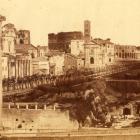Tommaso Cuccioni (1790-1864), attributed, “Rome. Roman Forum before the excavations, seen from the Capitoline hill", before 1864, salt print, 231x320 mm, inv. LV 1211
Famous engravers and painters were not the only artists to deal with the theme of antique monuments, Rome's antiquities also attracted famous photographers of urban landscapes: first and foremost the calotypists of the “Roman School”: Flacheron, Eugène Constant, Alfred Nicholas Normand, Giron des Anglonnes and the perspective painter who converted to photography, Giacomo Caneva. Successively other famous photographers such as Anderson, MacPherson, Ashby, Chaufforiers, Sommer, Tuminello, Cuccioni, Altobelli and D’Alessandri, to name but a few, also dedicated themselves to documenting the antiquities of the capital. The photograph documenting the appearance of the Roman Forum, before Pietra Rossa's excavations of 1871 is attributed to Tommaso Cuccioni, because of its similarity to another photograph by Cuccioni, an example of which can be found in the Dietmar Siegert collection in Munich and another in the Dario Reteuna collection in Turin.
Cuccioni became a print merchant in 1830 and with the advent of photography, began acquiring daguerreotypes for his shop in Via della Croce 88 and successively in Via dei Condotti 18, including those by Giacomo Caneva. Then from 1852 he took up photography himself, specialising in large format monumental scenery. He was praised at the Société Française de Photographie exhibition of 1859 for his scenes of the Roman forum, the colosseum, Laocoon and his Sons and the arch of Constantine.
In 1862 he took part in the London Exhibition with his views of Rome, including pictures dedicated to the fresco cycle by Annibale Carracci in the Farnese Palace.








